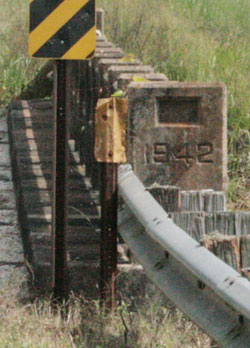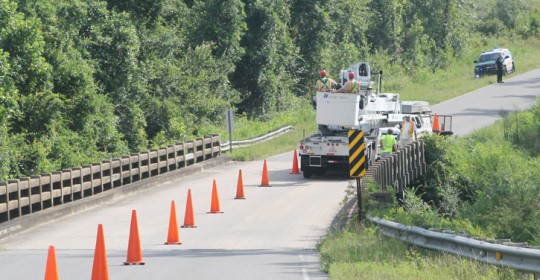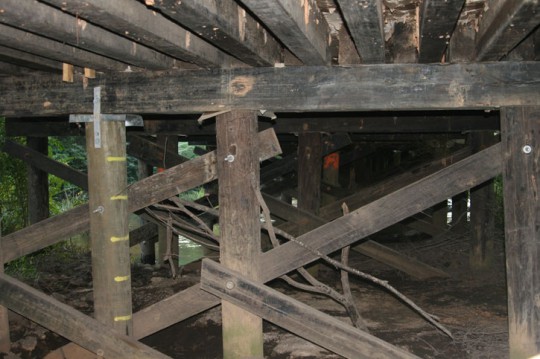50 North Escambia Bridges Need Replacing
July 10, 2012
Think the days of wooden bridges are long gone? Think again. Odds are if you travel an Escambia County road, you will travel over a bridge that has wooden supports under the concrete or asphalt that you see.
Many of Escambia County’s 128 bridges have wooden structures and/or wooden supports, and many are 50 to 70 years old. Eleven are classified as “structurally deficient” and seven are classified as “functionally obsolete”, according to a 2010 report.
The 2010 report says it would take $96.6 million to replace 103 of those bridges — including 50 bridges in North Escambia — within the next 10 years.
 The number one bridge on the county’s 2010 wooden substructure bridge priority list is on Fannie Road at Dead Lake, just outside Century. Built in 1960, the 121 foot bridge has a 10 ton weight limit. The bridge is slated to be replaced in 2014.
The number one bridge on the county’s 2010 wooden substructure bridge priority list is on Fannie Road at Dead Lake, just outside Century. Built in 1960, the 121 foot bridge has a 10 ton weight limit. The bridge is slated to be replaced in 2014.
Bridges like the one on Fannie Road are not dangerous, according to county officials, but they are aging and in need of replacement before they become dangerous or even deadly. While drivers see asphalt on the surface of the bridge, what they don’t see is the wood structure underneath.
Most of Escambia County’s bridges — all but 13 — are inspected at least every two years by the Florida Department of Transportation. The other 13, all bridges less than 20 feet wide, are inspected by a contractor hired by the county. Monday morning, the Highway 4 bridge over Canoe Creek was the latest bridge to be inspected (pictured top).
Other North Escambia wooden substructure bridges that are considered structurally deficient, with date of construction and replacement cost, are:
- Beck’s Lake Road across an unnamed branch, 1968, $640,000
- Pineville Road at Long Hollow Creek, 1968, $610,000
- Tungoil Road at McDavid Creek 1969, $860,000
- Lambert Bridge Road at Pine Barren Creek, 1967, $2.24 million
- Brickyard Road at an unnamed branch, 1960, $640,000
- Bet Raines Road at Jack’s Branch, 1967, $610,000
- Occie Phillips Road at Brushy Creek, 1968, $1 million
The county needs a total of $11.8 million to replace the bridges classified as structurally deficient and an additional $7.3 million to replace the ones that are classified as being functionally obsolete.
Other North Escambia wooden substructure bridges on the county’s priority replacement wish list, with date of construction and replacement cost, are:
- Highway 99A at Boggy Creek, 1969, $770,000
- Highway 97A at Boggy Creek, 1968, $1.48 million
- Highway 164 at Pine Barren Creek, 1958, $2.01 million
- Highway 99A at Little Pine Barren Creek, 1970, $1 million
- Highway 168 at an unnamed branch, 1968, $610,000
- Highway 168 at Reedy Creek, 1968,$730,000
- Highway 168 at Hobbs Branch, 1965, $1 million
- Nokomis Road at Brushy Creek, 1967, $1.33 million
- Molino Road at Alligator Creek, 1959, $860,000
- Schagg Road at Jack’s Branch, 1965, $890,000
- Molino Road at Penasula Creek, 1958, $610,000
- Gibson Road at Alligator Creek, 1959, $1.02 million
- Rigby Road at Beaver Creek Road, 1965, $1 million
- Chestnut Road at unnamed branch, 1967, $740,0000
- Pineville Road at Reedy Branch, 1964, $620,000
- Pine Barren Road at unnamed branch, 1964, $730,000
- McKenzie Road, 1961, $620,000
- Hanks Road at Breastworks Creek, 1968, $730,000
- Highway 99A at Freeman Springs Branch, 1968, $610,000
- Schagg Road at branch of Jack’s Branch, 1965, $620,000
- Sandy Hollow Road at Sandy Hollow Creek, 1959, $730,000
- Sunshine Hill Road at unnamed branch, unknown age, $470,000
- Stacy Road at unnamed branch, unknown age, $490,000
- Pine Top Lane at unnamed branch, unknown age, $480,000
- Chestnut Road at unnamed branch, unknown age, $480,000
- Breastworks Road at Hall’s Branch, unknown age, $490,000
Fourteen of 16 concrete or steel bridges and culverts classified as “priority two” for replacement, are in North Escambia:
- Highway 4 at Alligator Creek, 1949, $1.6 million
- Highway 196 at Jack’s Branch, 1949, $1.35 million
- Highway 4 at Canoe Creek, 1942, $2.59 million
- Highway 99 at Pine Barren Creek, 1955, $2.34 million
- Highway 196 at Penasula Creek, 1949, $1.5 million
- Highway 4 at Reedy Creek, 1942, $1.38 million
- Highway 99 at McDavid Creek, 1951, $2.1 million
- Highway 99 at Little Pine Barren Creek, 1955, $2.1 million
- County Road 4 at Beaver Creek Dam, 1940, $840,000
- Quintette Road at unnamed ditch, 1956, $580,000
- Greenland Road at Pine Barren Creek, 1955, $620,000
- Molino Road at Dry Creek, 1959, $780,000
- Highway 196 at unnamed branch, 1959, $550,000
- Highway 4 at Little Pine Creek, 1942, $640,000
There are additional concrete or steel bridges and culverts in North Escambia on a “priority three” replacement list, including:
- County Road 97 at Jack’s Branch, 1960, $1.96 million
- Highway 196 at Cowdevil Creek, 1961, $680,000
- Highway 168 at unnamed branch, 1967, $980,000
Pictured top and inset: The Highway 4 bridge at Canoe Creek, constructed in 1942 was inspect Monday morning. Replacing the bridge would cost the county an estimated $2.59 million. Pictured below: The wood structure of the bridge on Lambert Bridge Road near Walnut Hill. Replacing the bridge would cost an estimated $2.24 million. NorthEscambia.com photos, click to enlarge.
Comments
12 Responses to “50 North Escambia Bridges Need Replacing”





I thought Obama was going to take care of things like this with his Recovery and Reinvestment Act.
The observation wheel on PB is a 100% private deal.
In fact the county now makes more money from it due to increased annual property taxes and lease fees.
Most of the fuel taxes go to the state and then the counties have to beg for them to be spent in the county.
But yes, 100% of any taxes paid in another state never helps people in a different state.
REGARDING:
“While Rome is burning, the BOCC is authorizing money to be spent on P-cola Beach for an observation wheel that few will use.”
Be ye sure BOCC paid for it? Me know they don’t own it. ‘Twould be silly indeed to have paid for something someone else owns.
David for better bridges
One point that needs to be made when it comes to new construction or repair of county or municipal roadways in Escambia County (or any Florida County) is that purchasing fuel in your home county provides funds for local roads.
Those living in Florida who purchase a majority of fuel in neighboring counties, and especially in Alabama, contribute little or nothing to Escambia (FL) roadway budgets.
That’s how it works.
Before these bridges, logs were laid for the horse and buggies to cross creeks and branches.
While Rome is burning, the BOCC is authorizing money to be spent on P-cola Beach for an observation wheel that few will use. By the way, William, what are the numbers of riders for this new expensive beach toy? Take care of the infrastructure, Now!
Make the bridges that need replacing toll bridges. When enough toll money is collected for that bridge, use the money to build a new one.
Looking at the ages of those bridges, there sure were a lot of bridges built in the 1960’s.
I bet those timbers were treated with stronger chemicals than today…they were meant to last longer.
What Escambia County needs so bad is a group of county commissioners without tunnel vision. Had this situation been taken care of twenty years ago on a pay as you go basis it would all be complete by now. Seems they can only see to the end of their noses, and try to balance a budget that is totally irresponsible. We have an opportunity to better our selves by getting rid of all that come up for re-election. Let’s try something new for a change.
I wonder where our county will find the money to replace these bridges? I know our tax money isn’t well spent now…but I’m sure we’ll just borrow it. We can’t raise taxes or make more efficient use of money now can we?
So living in a humid environment with termites and other wood eating insects, why do we have the support structures of bridges made of wood? Will they replace them with something else or treat the wood? Just curious.